- This essay, with pictures, covers Spiritual
significance of Ayodhya, History of the region of Ayodhya, About Maru
Gurjara style of temple architecture and Architecture of Ram Mandir at Ayodhya.
Author
is amongst others a Conservationist, Ph. D. in Dravidian and Khmer temple
Architecture, Cambodia and Founder of Samrachanā - Heritage Conservation &
Research Initiative, Pune.
Introduction
After a struggle of around 500 years, finally, our
generation is fortunate to see the expedited process of the temple construction
of Shri Ram Mandir at the birthplace of Maryadapurushottam Prabhu Shri Ram. In
modern times, with the contribution of scholars like Senior Archaeologist B. B.
Lal., K.K. Mohammad, and others, one could consolidate the traces of earlier
temple remains. The image of the current temple was released somewhere in the
1980s while progressing the long ongoing movement of temple construction.
The original design for Ram Mandir was devised in
1988 by the Sompura family of Ahmedabad headed by Chandrakant Sompura who is
the chief architect of the temple assisted by his two sons, Nikhil Sompura and
Ashish Sompura. 1 These Sompuras
have contributed to the design of over 100 temples worldwide for at least 15
generations, including the Somnath temple. 2
The question raised by many people about the ‘design’ of the Ram temple. There are many assumptions made by people and ‘opinions’ are available widely. The hypothesis of many is that Shri Ram mandir at Ayodhya is made to look like Somnath temple, in Gujarat. Both these temples have a special place in the hearts of the people. Both of these are hundreds of kilometers away and were constructed after independence in 1947 to reinstate the pride of Hindus and mark the epitome of Hindu beliefs.
However, there is a logical explanation about the
architectural style selected for these temples, and also there is a reason why
these two are similar. These reasons are beyond their current political
patronage.
This article attempts to describe the architectural
style of the new Ram temple and its nuances. It gives a detailed account of the religious
and architectural continuity of heritage in this region. Article covers-
1. Spiritual significance of Ayodhya.
2. History of the region of Ayodhya.
3. Gurjara-Pratihara dynasty.
4. Brief about the Maru Gurjara style of temple architecture in India.
5. Ram Mandir at Ayodhya includes architecture.
To make article shorter, removed section 3 Gurjara.
You can read full article by clicking on this PDF
1. The
spiritual significance of the Place of Ayodhya
The Sapta Puri (Sanskrit सप्त-पुरी, saptapurī, "seven cities") are a group of seven Hindu tirtha, or holy pilgrimage sites, located in India. Pilgrimage to these sites is said to bless the pilgrim with moksha (liberation from the cycle of birth and death).
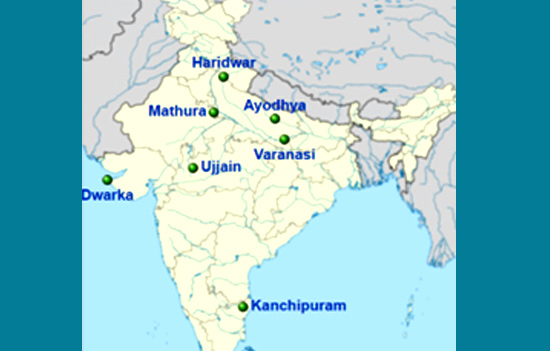
A śloka from the Garuda Purana describes the seven places:
अयोध्या मथुरा माया काशी काञ्ची अवन्तिका।
पुरी द्वारावती चैव सप्तैते मोक्षदायकाः॥
3
Meaning:
1: Ayodhya, Mathura, Maya (Mayapuri or Haridwar),
Kashi (Varanasi), Kanchi (Kanchipuram), Avantika (Ujjain) ...
2: ... and Dwaravati (Dwaraka); These seven cities
are givers of Moksha (Liberation) (and are called Mokshapuri).
Ayodhyā, Mathurā, Mayā, Kaśī, Kañchi, Avantikā, Dwārāvatī, these seven cities should be known as the givers of liberation.
So Ayodhya is the first out of 7
important places for Hindus for spiritual liberation. Every
Hindu wishes to visit these seven cities in their lifetime even in modern
times.
Ayodhya is the place where Shri Rama was born. The modern town is located on the banks of river Sharayu. There are over 100 temples in this town, a few of these are the Temple of Rama and his wife Sita, called the Kanak Bhavan; the Hanuman temple called the Hanuman Garhi on top of a hill where, apart from a Hanuman statue in a sitting posture, there is also a 6 inches (15 cm) tall image of Hanuman always bedecked by flowers; the Kshireshwaranath temple of Sita, established by Kausalya, Rama's mother. 4 In addition, there are several kunds and ghats with linkage to characters; such as the Brahma kund built in honor of Brahma's visit here, Sita kund, Bharat kund, Lakshman ghat where Lakshman, Rama's brother took a bath, Rama ghat (also called Swargadwar meaning gateway to heaven). 5
2. History
of the region of Ayodhya
Ayodhya, meaning unconquerable, has been part of India’s oral history through its epic- Ramayana, which was the capital of the legendary Ikshvaku kings of Kosala, including Rama. 6 According to the Ramayana, Ayodhya was founded
by Manu, the progenitor of mankind, and measured 12x3 yojanas in area. 7 Both Ramayana and Mahabharata
describe Ayodhya as the capital of the Ikshvaku dynasty of Kosala, including
Rama and Dasharatha. The Purana-Pancha-Lakshana also describes the city as the
capital of Ikshvaku kings, including Harishchandra. 8
Buddhist Pali literature like Samyutta Nikaya and the Vinaya Pitaka mentions this city named Saketa near Shravasti which is believed to be the city of Ayodhya. Jain Prakrit-language texts mention this city called Saketa (Sageya or Saeya in Prakrit) as an important city of the Kosala Mahajanapada. Fourth century onwards, multiple texts, including Kalidasa's Raghuvamsha, mention Ayodhya as another name for Saketa.
The later Jain canonical
text Jambudvipa-Pannati describes a city called Viniya as the birthplace of Lord Rishabhanatha, and associates this city with Bharata Chakravartin; the Kalpa-Sutra describes Ikkhagabhumi as the birthplace of Rishabhadev. The index on the Jain text Paumachariya clarifies that Aojjha (Aodhya), Kosala-puri ("Kosala city"), Viniya, and Saeya (Saketa) are synonyms. The post-Canonical Jain texts also mention "Aojjha". For example, the Avassagacurni describes it as the principal city of Kosala, while the Avassaganijjutti names it as the capital of Sagara Chakravartin. The Samyutta Nikaya and Anguttara Nikaya mention that Buddha resided at Saketa at times. The early Jain canonical texts (such as Antagada-dasao, Anuttarovavaiya-dasao, and Vivagasuya) state that Mahavira visited Saketa; Nayadhammakahao states that Parshvanatha also visited Saketa. The Jain texts, both canonical and post-canonical, describe Ayodhya as the location of various shrines, such as those of snake, yaksha Pasamiya, Muni Suvratasvamin, and Surappia.
Archaeological and literary evidence suggests that the site of present-day Ayodhya had developed into an urban settlement by the 5th or 6th century BC. The site is identified as the location of the ancient Saketa city, which probably emerged as a trade center located at the junction of the two important roads, the Shravasti-Pratishthana north–south road, and the Rajagriha-Varanasi-Shravasti-Taxila east–west road. As a busy town frequented by travelers, it appears to have become important for preachers such as Gautama Buddha and Mahavira.
It continued to be an important center during the Maurya rule and was part of the Magadha Empire.
Excavations at Ayodhya have resulted in the discovery of a large brick wall,
identified as a fortification wall by archaeologist B. B. Lal. This wall was probably erected in the
last quarter of the third century BC. After the decline of the Maurya empire, Saketa appears to have come under the rule of Pushyamitra Shunga. The first-century BC inscription of Dhanadeva suggests that he appointed a governor there. The Yuga Purana mentions Saketa as the residence of a governor and describes it as being attacked by a combined force of Greeks, Mathuras, and Panchalas. Patanjali's commentary on Panini also refers to the Greek siege of Saketa.
The Vayu Purana and the Brahmanda Purana also state that seven powerful kings ruled in the capital of Kosala. The historicity of these kings is attested by the discovery of the coins of the Deva dynasty kings, including Dhanadeva, whose inscription describes him as the king of Kosala (Kosaladhipati). The east–west route connecting Pataliputra to Taxila, which earlier passed through Saketa and Shravasti, appears to have shifted southwards during this period, now passing through Saketa, Ahichhatra, and Kanyakubja.
After the Deva kings, Saketa appears to have been ruled by the Datta, Kushan, and Mitra kings, although the chronological order of their rule is uncertain. Historian Bakker theorizes that the Dattas succeeded the Deva kings in the mid-1st century AD, and their kingdom was annexed to the Kushan Empire by Kanishka. Saketa appears to have remained a prosperous town during the Kushan rule. Before or after the Kushans, Saketa appears to have been ruled by a dynasty of kings whose names end in "-Mitra", and whose coins have been found at Ayodhya. They may have been members of a local dynasty that was distinct from the Mitra dynasty of Mathura. These kings are attested only by their coinage: Sangha-mitra, Vijaya-mitra, Satya-mitra, Deva-mitra, and Arya-Mitra; coins of Kumuda-sena and Aja-varman have also been discovered.
Later, an important development during the Gupta
time was the recognition of Saketa as the legendary city of Ayodhya. The 436 AD
Karamdanda (Karmdand) inscription, issued during the reign of Kumaragupta-I, names Ayodhya as the capital of the Kosala province, and records commander Prithvisena's offerings to Brahmins from Ayodhya. Later, the capital of the Gupta Empire was moved from Pataliputra to Ayodhya. Paramartha states that King Vikramaditya moved the royal court to Ayodhya. Xuanzang also corroborates this, stating that this king moved the court to the "country of Shravasti", that is, Kosala. A local oral tradition of Ayodhya, first recorded in writing by Robert Montgomery Martin in 1838, mentions that the city was deserted after the death of Rama's descendant Brihadbala. The city remained deserted until King
Vikrama of Ujjain came searching for it, and re-established it. He cut
down the forests that had covered the ancient ruins, erected the Ramgarh fort,
and built 360 temples.
After the fall of Harsha's empire, Ayodhya appears to have been variously controlled by local kings and the rulers of Kannauj, including Yashovarman and the Gurjara-Pratiharas. Archaeological evidence including images of Vishnu, Jain Tirthankaras, Ganesha, the Sapta Matrikas, and a Buddhist stupa suggests that the religious activity in the area continued during this period. The latest remains of the
temples, idols, and symbols found on site, are majorly from the
Gurjara-Pratihara period in Ayodhya.
This
gives a brief justification of the architectural style selected for the new
temple to be constructed at Ayodhya at Ram Janmabhoomi.
3. Gurjara-Pratihara
Dynasty
The Gurjara-Pratihara was a dynasty that ruled much
of Northern India from the mid-8th to the 11th century. They ruled first at
Ujjain and later at Kannauj. The
Gurjara-Pratiharas were instrumental in controlling Arab armies moving east of
the Indus River. Nagabhata-I (730–760 AD) defeated the Arab army which attacked India under Junaid and Tamin. In the Gwalior inscription, it is recorded that Gurjara-Pratihara emperor Nagabhata "crushed the large army of the powerful Mlechcha king." Kannauj became the center of the Gurjara-Pratihara state, which covered much of northern India during the peak of their power, c. 836–910.
To read more about Gurjara-Pratihara dynasty
download PDF or click Here
. Some temples made by Pratihara kings are Teli-ka
Temple in Gwalior Fort , Bateshwar
Temples Morena and Osian Jain
Temple near Jodhpur
4. Brief
about the Maru Gurjara style of temple architecture in India
Māru-Gurjara architecture or Solaṅkī style is the
style of West Indian temple architecture that originated in Gujarat and
Rajasthan from the 11th to 13th centuries, under the Chaulukya dynasty also
called Solaṅkī dynasty. 11 The ancient name of Rajasthan was Marudesh while Gujarat was called Gurjaratra. The term "Māru-Gurjara" was coined by art and architectural historian Madhusudan Dhaky, who also coined the terms "Surāṣṭra", "Mahā-Māru", and "Mahā-Gurjara" to describe other historical styles of Western Indian architecture. 12 The Māru-Gurjara style is a
synthesis of the Mahā-Māru style of Marwar region in Rajasthan and the
Mahā-Gurjara style of Gujarat.
Although originating as a regional style in Hindu
temple architecture, it became an especially popular temple style and mainly
under Jain patronage later spread across India, then later to diaspora
communities around the world. The style
developed from that of the dynasties preceding the Solankis, mainly the
Gurjara-Pratihara dynasty, and the local dynasties under it. Many of the broad
features of this earlier style are continued in the Māru-Gurjara style.
 Ambika Mata temple in Jagat, Rajasthan, by 960. Pic by Author.
Ambika Mata temple in Jagat, Rajasthan, by 960. Pic by Author.
 Ambika Mata temple in Jagat, Rajasthan, by 960. Pic by Author.
Ambika Mata temple in Jagat, Rajasthan, by 960. Pic by Author.
The
beginnings of the new style can be seen in the small Ambika Mata temple in
Jagat, Rajasthan. The earliest inscription here records a repair in 961 which
was well before the Solankis came to power. 13
This style of temple architecture is another form of the Nagar style of architecture preceding to this like the Chandela temples of Khajuraho. As per George Mitchell, in the Jagat temple (and others he names) "the Pratihara style was fully evolved in its Western Indian expression". The main temple characteristic of these temples is that the shikhara has a curvilinear shape. In
later examples, free-standing Kirti-Toranas and a Kunda or a temple tank could
be found at the front of the temples. It started as a regional form but soon
acquired supra-regional dimensions.
The Maru-Gurjara temples have 3
divisions in their elevation, namely, The pitha, The main hall
called mandovara, and the shikhara. The whole temple stands on a khara-sila which is similar to the
Jagati of the other Nagar temples.
The mandovara is the temple wall of the
Maru-Gurjara temples. It has 3 main sections, namely, The vedhi-bandha
is a series of binding moldings around the main portion of the wall, The Jangha
is the main part of the wall, and the varandika is the series of
moldings in the form of cornices. The varandika is finally topped by a
projecting sun shade in the shape of ribbed tiles, known as khurachadya.
Shikhara-At the
base of the shikhara is the rathika bearing an image of a deity. The
curvilinear shikhara is topped by a massive amalaka over which rests the
candrika (capstone) and kalasha.
Gudha-mandapa: The
roof of the mandapa is either the phamsana (stepped-pyramidal) or samvarana
(bell roof).
The tangled carvings on the walls of the temples
demonstrate that the art of sculpture had attained its height. The heavy
carvings on the ceilings of the Mandapa create a distinctive style of these
temples. The decorative themes include lines of horse riders, elephants, and
kīrttimukhas. No surface is left undecorated. The heavy sculptural treatment of
the architecture indicates a link between Maru-Gurjara architecture.
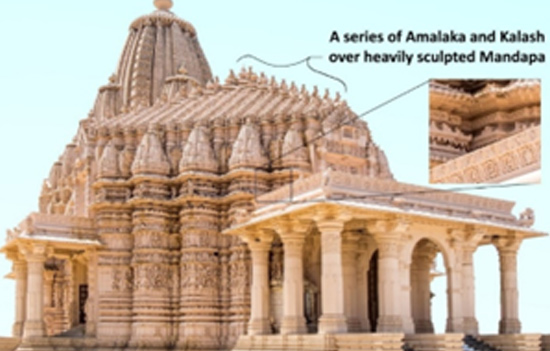 Ajitnath Temple. Pic by author.
Ajitnath Temple. Pic by author.
 Ceiling decorations at Sun Temple, Modhera. Pic by author.
Ceiling decorations at Sun Temple, Modhera. Pic by author.
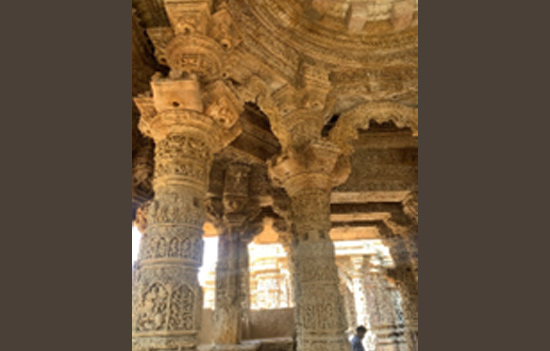 Structural composition at Sun Temple, Modhera. Pic by author.
Structural composition at Sun Temple, Modhera. Pic by author.
A few of the earlier temple made by the Maru-Gurjara
dynasty are:
The Somnath temple, dedicated to Shiva, was the most famous in Gujarat but was very largely destroyed by the Ghaznavid ruler Mahmud in a raid in 1024–1025 CE. It was then rebuilt but sacked again when the Delhi Sultanate conquered the area at the end of the 13th century. 14 The ruins
have recently been restored and rebuilt in what is intended as the Solanki
style.
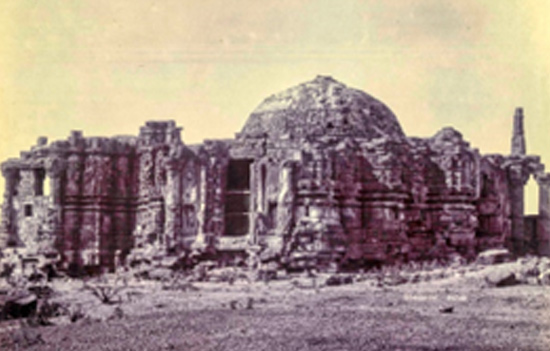 Archival photo of Ruins of Somnath Temple, Gujarat.
Archival photo of Ruins of Somnath Temple, Gujarat.
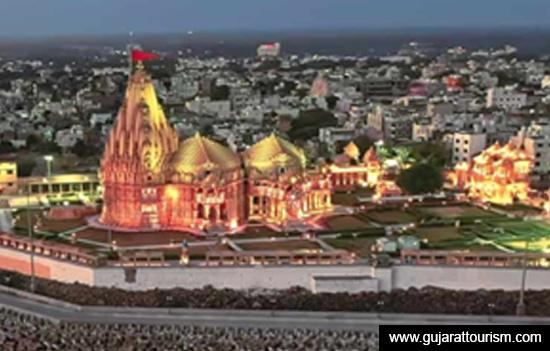 Reconstructed Temple of Somnath.
Reconstructed Temple of Somnath.
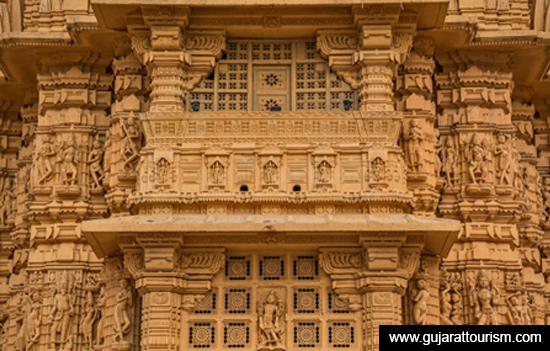 Somnath temple.
Somnath temple.
The Sun Temple, Modhera, Gujarat, was built in 1026–27 CE, just after Mahmud Gazni's raid. The shikhara is now missing, but the lower levels are well-preserved, and there is a large step well tank of the same period in front of the temple. There is a
large detached mandapa between the main sanctuary building and the tank, which
is slightly later. The carving of all parts is extremely luxuriant and
exquisitely refined in the rendering of detail.
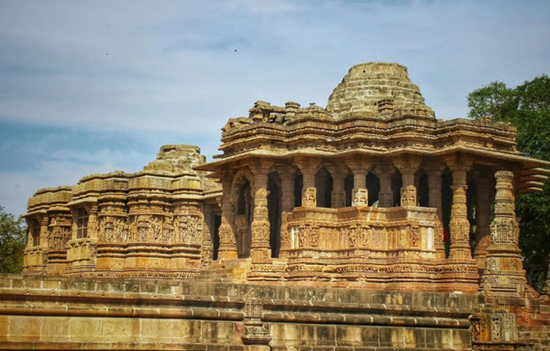 Sun Temple Modhera, Gujarat. Pic by author.
Sun Temple Modhera, Gujarat. Pic by author.
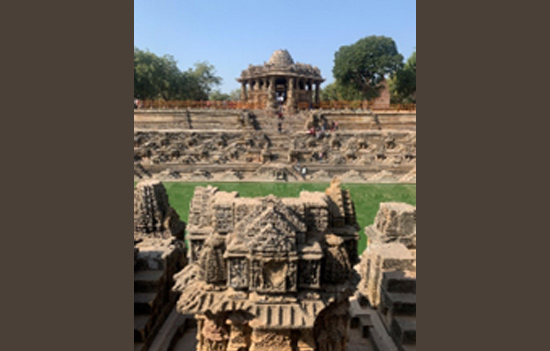 Sun Temple Modhera, Gujarat. Pic by author.
Sun Temple Modhera, Gujarat. Pic by author.
 Plinth of Sun Temple. Pic by author.
Plinth of Sun Temple. Pic by author.
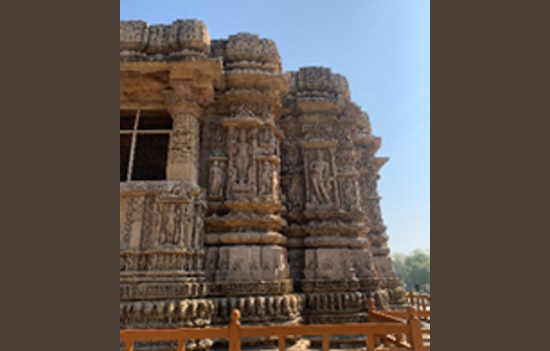 External Wall composition of Sun Temple. Pic by author.
External Wall composition of Sun Temple. Pic by author.
This style of
architecture is also adopted by many Jain temples in Gujarat and Rajasthan and has
been followed till today. A few famous temples are Dilwara Temple at Mount Abu,
The Ajitanatha Temple, the largest and earliest of the cluster of Taranga Jain
temples, constructed in 1161, Kumbharia Jain temples- a complex of five Jain
temples in Kumbhariya, Banaskantha district built between 1062 - 1231 CE, the
Bhadreshwar Jain Temple, constructed in 1248, The clustered group of Girnar
Jain temples constructed from 1128, 1231, 1453 and another 15th-century. Many
of these temples are destroyed during Islamic invasions.
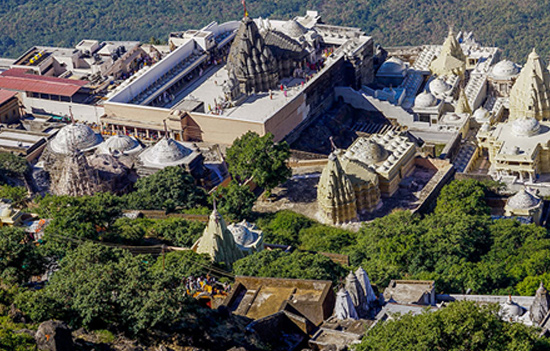 Girnar temples. Pic courtesy gujarattourism.com
Girnar temples. Pic courtesy gujarattourism.com
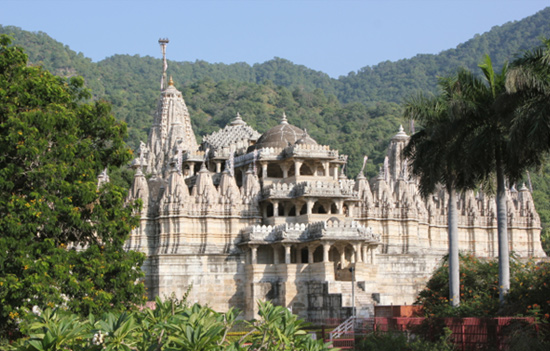 Adinatha temple at Ranakpur, Rajasthan built in Maru-Gurjara style. Pic by Julia A. B. Hegewald 15
Adinatha temple at Ranakpur, Rajasthan built in Maru-Gurjara style. Pic by Julia A. B. Hegewald 15
5. Ram Mandir at Ayodhya
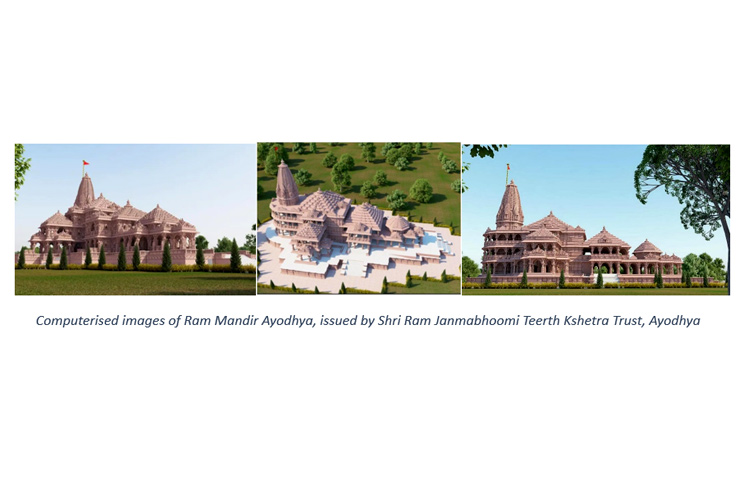
The original
design for Ram Mandir was planned in 1988 by the Sompura family of Ahmedabad.
However, it went through certain changes in 2020, including the Vastu shastra
and the Shilpa shastras. The Sompuras have contributed to the design of over
100 temples worldwide for at least 15 generations, including the Somnath
temple.
Salient Features of Shri Ram Mandir
The Shri Ram Janmabhoomi Temple construction is managed wholly by the Shri Ram Janmabhoomi Teerth Kshetra Trust. The estimated cost of the temple's construction is expected to range between ₹ 1,400 crore to ₹ 1,800 crore.
Architecture of Main Temple
The Ram Mandir
in Ayodhya is designed in traditional Nagar architectural style with a Maru
Gujarat sub-style. The temples are built with stone or brick on a square or
rectangular plane with shikhara located in the center. In this architectural
style, the temple is surrounded by small towers called Mukha Mandapa.
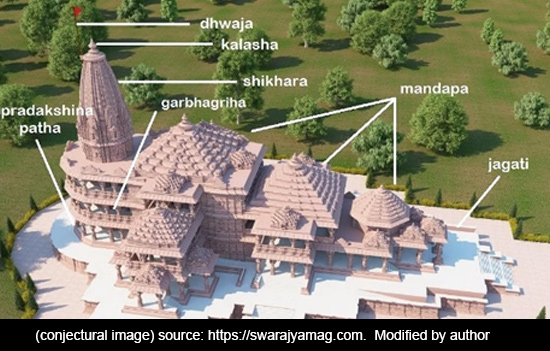 Various important Architectural features (conjectural image).
Various important Architectural features (conjectural image).
 Mandapas of temple.
Mandapas of temple.
A few facts stated by the trust are
The
temple is in the traditional Nagar style. The temple has a length (east-west)
of 380 feet, a width of 250 feet, and a height of 161 feet. It is
three-storied, with each floor being 20 feet tall. There will be a total of 392
pillars and 44 gates in the temple.
The Garbha-griha will have a Ram
Lalla, in a child form. Shri Ram Darbar will be housed on the first floor.
5 mandaps will adorn the temple-Nritya
mandapa, Ranga mandapa, Sabha Mandapa, Prarthana mandapa and Kirtana
mandapa.
All the pillars and walls of the
temple are decorated with statues and sculptures of gods, goddesses, and other
figurines very peculiar feature of the Maru Gurjara style of Temple
architecture.
Temple is housed on a high platform
i.e. Jagati. Entry to the temple is from the East side and there will be a
flight of 32 steps, the name of the main entry is Sinhadwar. The temple is
universally accessible to make sure that even the elderly and physically
challenged will be taken care of.
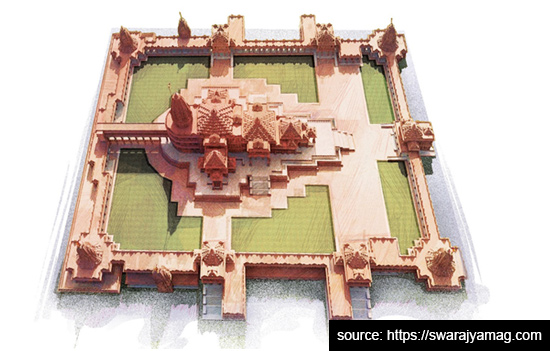 Square-shaped Prakara of temple and corner temples of different deities.
Square-shaped Prakara of temple and corner temples of different deities.
The prakara or the enclosure wall
around the temple is square with each side measuring 732 m and the width of
this is 14 feet.
The four corners will have four temples of the deity Sun, Bhagawati, Ganapati, and Shiva. On the northern side of the complex is Annapoorna goddess’s temple. And the southern side will have the Hanuman temple.
Sita kund is also part of the complex,
which also has a mythological significance.
The temple complex will also have
temples dedicated to Valmiki, Vasishtha, Vishwakarma, Agastya, and Shabri along
with Devi Ahilya. The ancient temple of Shiva which was on site already been
renovated with Navratna Kuber Tile in the southwestern part and a statue of
Jatayu is also been installed there.
The temple is constructed using all the modern scientific knowledge of services and support systems keeping the material authentic and traditional Indian material used for temples in India. It is said that the stone is brought from Bundelkhanda, granite from Karnataka, Marble from Makrana, Balua stone from Bharatpur, timber for doors from Ballarsha, masons for carving from Hyderabad, masons from Tamilnadu, and Odisha. The inclusion of soil from Thailand in the consecration ceremony symbolizes a global recognition of Lord Rama’s legacy. It transcends geographical boundaries, reinforcing the universal appeal of Ayodhya as a spiritual center.
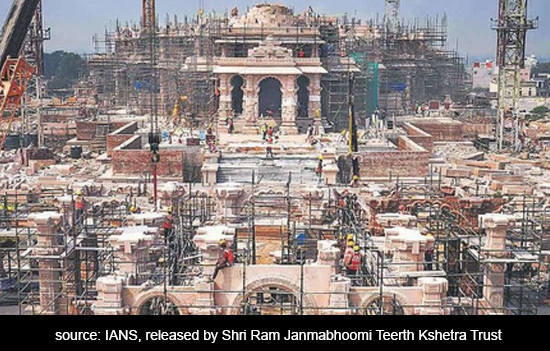 Ram Mandir under construction.
Ram Mandir under construction.
The temple is constructed using
traditional Indian materials, using indigenous technology, however, special
attention is given to the environment and water conservation.
In conclusion, along with being a
testament to religious faith, Shri Ram Mandir stands as
an architectural marvel. The temple, with its
rich symbolism and cultural resonance, stands as to endure legacy of Rama and
the collective spirit of the devotees involved in its creation. The temple
architecture truly justifies the style of architecture of the archaeological findings
as well as the following temples constructed during the period from the 7th
to 11th century which is also a significant timeframe when other
eminent temples were constructed by Maru Gurjara kings in the region.
As a living spiritual heritage of
India, the temple endures the legacy of Shri Rama. This temple will go a long
way in making Ayodhya the spiritual capital of India.
To read
all articles by author
References
1. Pandey, Alok (23 July 2020). "Ayodhya's Ram Temple Will Be 161-Foot Tall, An Increase Of 20 Feet". NDTV. Archived from the original on 25 August 2021. Retrieved 23 July 2020.
2. Sampal, Rahul (28 July 2020). "Somnath, Akshardham & now Ram Mandir – Gujarat family designing temples for 15 generations". ThePrint. Archived from the original on 29 July 2020.
3.
A śloka from the Garuda Purana describes the seven pilgrimage centers
4. Sunita Pant Bansal (2008). Hindu Pilgrimage. Pustak Mahal. pp. 6–9 & 34–35. ISBN 9788122309973. 5. Ring, Trudy; Salkin, Robert M.; Schellinger, Paul E.; La Boda, Sharon (1996). International Dictionary of Historic Places: Asia and Oceania. Taylor & Francis. pp. 47–50. ISBN 9781884964046.
6.
Bakker, Hans (1984), Ayodhya, Part 1: The History of Ayodhya from the seventh
century BC to the middle of the 18th century, Groningen: Egbert Forsten, ISBN
90-6980-007-1
7.
K. D. Bajpai (1967). The Geographical Encyclopaedia of Ancient and Medieval
India: Based on Vedic, Puranic, Tantric, Jain, Buddhistic Literature and
Historical Records. Indic Academy.
8.
Hans T. Bakker (1984). Ayodhya. Institute of Indian Studies, University of
Groningen. OCLC 769116023
9.
Avari, Burjor (2007). India: The Ancient Past. A History of the
Indian-Subcontinent from 7000 BC to AD 1200. New York: Routledge. ISBN
978-0-203-08850-0. x Chaurasia, Radhey Shyam (2002). History of Ancient India:
Earliest Times to 1000 A. D. Atlantic Publishers & Distributors. p. 207.
ISBN 978-81-269-0027-5.
11.
Michell, George, (1977) The Hindu Temple: An Introduction to its Meaning and
Forms, 1977, University of Chicago Press, ISBN 978-0-226-53230-1
12. Dhaky, M.A. (1983) ‘The Genesis and Development of Maru-Gurjara temple architecture’, in Encyclopaedia of indian temple architecture. New Delhi: American Institute of Indian Studies, pp. 114–203.
13.
Harle, J.C., The Art and Architecture of the Indian Subcontinent, 2nd edn.
1994, Yale University Press Pelican History of Art, ISBN 0300062176
14.
Rowland, Benjamin, The Art and Architecture of India: Buddhist, Hindu, Jain,
1967 (3rd edn.), Pelican History of Art, Penguin, ISBN 0140561021
15
Hegewald Julia A. B. , the international jaina style? Māru-Gurjara Temple.
Every
effort has been made to give references. In case have missed out any, it is unintended
and without malafide intent. Please write to me with details and shall do the needful.